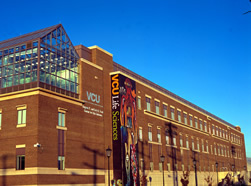Welcome to Lindsay Rekuc's AE Senior Thesis e-Portfolio
Building Statistics
Building Name: Eugene P. and Lois E. Trani Center for Life Sciences
Location: 1000 W. Cary St.
P.O. Box 842030
Virginia Commonwealth University
Richmond, VA 23284
Building Occupant Name: Virginia Commonwealth University Life Sciences
Occupancy: Classrooms, Offices, & Laboratories
Size: 132,500 sq. ft.
Number of Stories Above Grade: 3 Stories
Primary Project Team:
Owner: Virginia Commonwealth University
http://www.vcu.edu/
General Contractor: Alexander Contracting
http://www.alexanderbuilding.com/index.asp
Architects: Ayers Saint Gross
http://www.asg-architects.com/
Engineers: Sverdrup (Jacobs Facilities)
http://www.jacobs.com/
Lab Consultant: GPR
Dates of Construction:
Start: 1999
Completed: 2001
Total Construction Cost: $22 million
Project Delivery Method: Public Bid, low bid, fixed price, GC
Architecture:
The VCU Life Sciences Building was completed in 2001 in Richmond, Virginia. It has since been functioning as a teaching/ learning laboratory space. Included are classrooms, faculty offices, research laboratories, and a greenhouse. The VCU Life Sciences Building was built to reflect the architecture of the VCU campus and be a modern academic building. It is split into two main buildings, the lab areas and the lecture halls, connected by a pedestrian walkway. One of the most prominent features is a greenhouse located on the 3rd floor.
Major National Codes:
Virginia Uniform Statewide Building Code (VUSBC)
International Mechanical Code- 1996
International Plumbing Code- 1995 with 1996 Supplement
NFPA 10- 1994 Portable Fire Extinguishers
NFPA 13- 1994 Installation of Sprinkler Systems
NFPA 14- 1993 Standpipe and Hose Systems
NFPA 70- 1996 National Electric Code
NFPA 72- 1993 National Fire Alarm Code
Zoning: Lecture Area complies with A-3
Research Laboratories complies with E
Historical Requirements: Does Not Apply
Building Envelope:
The VCU Life Sciences Building façade consists of a modular brick with a running bond and precast concrete. Both steel and aluminum window types are used. The roofing system is rigid insulation board on galvanized roof deck. The greenhouse consists of an all glass façade with 1/4“ thick glass. It has a gable roof also consisting of the same glass.
Construction:
The General Contractor for The VCU Life Sciences Building was Alexander Contracting. Construction began in 1999 and was completed in the summer of 2001. The total project cost was $22 million.
Electrical:
A utility transformer provides power to the main switchboard in The VCU Life Sciences Building. The power system is radial and connects to lighting and power panelboards, motor control centers, automatic transfer switches, and emergency lighting and standby equipment panelboards.
Lighting:
Lighting in the classroom section of The VCU Life Sciences Building is controlled through a dimming panel. The typical lamps throughout both the classroom and laboratory sections of the building are fluorescent and incandescent. A time control system is in place for lighting in the aquatics and animal facilities. The site lighting is monitored using both photosensor and time controls. The site lamps are metal halide.
Mechanical:
There is a greenhouse located on the west end of the third floor of The VCU Life Sciences Building. It uses desiccant air handling units, whereas the rest of the building uses rooftop air handling units. However, there are also special exhaust valves for the laboratories. There are also emergency rooftop air conditioning units for the aquatics and animal facilities.
Structural:
The VCU Life Sciences Building's foundation is slab on grade with spread footings. It has a steel frame with a metal deck and concrete fill, supported by composite beams.
Fire Protection :
In The VCU Life Sciences Building, there is a fire alarm system installed throughout. It consists of control panels, annunciator panels, digital alarm communication transmitters, electro-magnetic door open devices, heat and smoke detectors, sprinkler flow switches, alarm pressure switches, sprinkler valve tamper switches, monitor and control modules, and combination horn and strobes.
Telecommunications:
The telephone and data systems are accessible in almost every room of The VCU Life Sciences Building. Conduit is run on each of the floors along each side of the main hallway and then tap out into each room. Telephone lines and internet lines can then be accessed from almost any room in the building. There are also emergency telephone lines for public use installed near the stairwells in the corridors.
